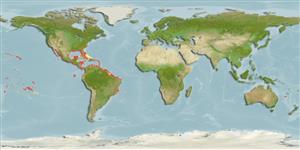Common names from other countries
Teleostei (teleosts) >
Tetraodontiformes (Puffers and filefishes) >
Tetraodontidae (Puffers) > Tetraodontinae
Etymology: Sphoeroides: Greek, sphaira = ball + Greek, suffix, oides = similar to (Ref. 45335).
More on author: Gilbert.
Environment: milieu / climate zone / depth range / distribution range
Ecology
Marine; brackish; reef-associated. Tropical
Western Atlantic: Honduras to Santa Catarina, Brazil (Ref. 57756).
Length at first maturity / Size / Weight / Age
Maturity: Lm 7.0 range ? - ? cm
Max length : 22.6 cm TL male/unsexed; (Ref. 124486); common length : 14.0 cm TL male/unsexed; (Ref. 5217)
Dorsal spines (total): 0; Dorsal soft rays (total): 8; Anal spines: 0; Anal soft rays: 7. Upper two-thirds of head and body with groups of small dark brown spots; whitish ventrally; caudal fin with a dusky bar basally and a 2nd but fainter dark bar in outer middle part of fin (Ref. 13442).
Found over soft bottoms generally with vegetation such as Thalassia testudinum. Prefers turbid water (Ref. 9710). Feeds on marine invertebrates (Ref. 36453). Locally consumed but its visceral organs may be toxic.
Life cycle and mating behavior
Maturities | Reproduction | Spawnings | Egg(s) | Fecundities | Larvae
Cervigón, F., R. Cipriani, W. Fischer, L. Garibaldi, M. Hendrickx, A.J. Lemus, R. Márquez, J.M. Poutiers, G. Robaina and B. Rodriguez, 1992. Fichas FAO de identificación de especies para los fines de la pesca. Guía de campo de las especies comerciales marinas y de aquas salobres de la costa septentrional de Sur América. FAO, Rome. 513 p. Preparado con el financiamento de la Comisión de Comunidades Europeas y de NORAD. (Ref. 5217)
IUCN Red List Status (Ref. 130435)
CITES (Ref. 128078)
Not Evaluated
Threat to humans
Reports of ciguatera poisoning (Ref. 31174)
Human uses
Fisheries: commercial
Tools
Special reports
Download XML
Internet sources
Estimates based on models
Preferred temperature (Ref.
115969): 23.5 - 28.4, mean 27.3 (based on 1083 cells).
Phylogenetic diversity index (Ref.
82804): PD
50 = 0.5000 [Uniqueness, from 0.5 = low to 2.0 = high].
Bayesian length-weight: a=0.01950 (0.01594 - 0.02386), b=2.90 (2.86 - 2.94), in cm Total Length, based on LWR estimates for this species (Ref.
93245).
Trophic level (Ref.
69278): 3.5 ±0.37 se; based on food items.
Resilience (Ref.
120179): High, minimum population doubling time less than 15 months (Preliminary K or Fecundity.).
Fishing Vulnerability (Ref.
59153): Low vulnerability (13 of 100).
